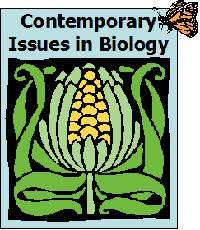
Week 15, Chapter 12 -- Adopt-a-Species Sample Assignment
Course home | Weekly schedule | Announcements | Instructor Info | Desire2Learn | MasteringBiology® | Honor Code | FAQs | HELP!
 |
Week 15, Chapter 12 -- Adopt-a-Species Sample AssignmentCourse home | Weekly schedule | Announcements | Instructor Info | Desire2Learn | MasteringBiology® | Honor Code | FAQs | HELP! |
Dear boss,
At your request, I am providing you with this report on the selective breeding potential of the Kanab ambersnail. Here is a complete classification for the snail:
This snail is nicely adapted to its wetland habitat. Three examples of its adaptations are:
I have chosen the shell as our target for selective breeding. These snails have beautiful shells, but unfortunately the snail is very small – only about 1 inch at maturity. Small, amber-colored shells might be useful in jewelry, but the shells are fragile. It might be possible to begin a selective breeding program that would accomplish two things: it would increase the size of the shell, making it large enough to find other uses, such as a decorative element in lampshades. (The light shining through the amber shell would be lovely). At the same time, to be useful in a household, the shell would need to thicker and tougher.
The snails’ habitat is very limited, but we can travel to Utah, Arizona, or Colorado and try to get permission to collect a few specimens. It will take some research to determine how best to maintain the snails in captivity. For example, what temperature do they prefer? Do they need any special foods or living conditions to breed? Do they prefer certain mates, or do they mate pretty much at random? Do they self-fertilize even if other mates are available? Assuming we can answer these questions, we will raise the snails in our lab, and, for the first generation, we will allow them to mate at random. Once the offspring reach maturity, we can select a few snails with the largest, thickest shells. We can release the rest of the snails back into their natural habitat, then allow only the “selected” ones to breed. We will continue this process of selection for as many generations as it takes to for most of the snails to produce useful (large and thick) shells.
In planning this breeding experiment, it occurred to me that we may actually create a new species of snail. Scientists know little about the breeding preferences of the Kanab ambersnail. If the snails use the size or color of the shell as a cue for selecting mates, our newly developed snail may not be attractive to the “natural” snails. So if our new snails were released into the environment, they may not breed with the original population (this is called reproductive isolation). The biological definition of “species” relies on the potential to interbreed. If our new snails no longer breed with the originals, we will, by definition, have a new species.
I can see some potential benefits to this work, but I also have some ethical concerns. Among the good things, the vast market for beautiful amber-colored ornaments means we might make money. Also, we will learn about the reproductive biology of the Kanab ambersnail, which may help with the conservation of this endangered species. But on the other hand, I wonder if the removal of some breeding snails from their habitat would hasten the extinction of the species. That concern, coupled with the availability of ornamental amber plastic and glass, makes me think that we should pursue other breeding opportunities at this time.
[656 words]